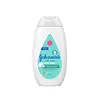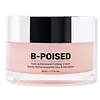What's inside
What's inside
 Key Ingredients
Key Ingredients

 Benefits
Benefits

 Concerns
Concerns

 Ingredients Side-by-side
Ingredients Side-by-side

Water
Skin ConditioningIsopropyl Palmitate
EmollientGlycerin
HumectantCocoglycerides
EmollientCetyl Alcohol
EmollientPEG-100 Stearate
Dimethicone
EmollientPhenoxyethanol
PreservativeCarbomer
Emulsion StabilisingGlyceryl Stearate
EmollientParfum
MaskingP-Anisic Acid
MaskingSodium Hydroxide
BufferingEthylhexylglycerin
Skin ConditioningDisodium EDTA
Panthenol
Skin ConditioningTocopheryl Acetate
AntioxidantXanthan Gum
EmulsifyingSodium Ascorbyl Phosphate
AntioxidantMilk Protein
Skin ConditioningHydrolyzed Rice Bran Protein
Skin ConditioningMagnesium Aspartate
Skin ConditioningZinc Gluconate
Skin ConditioningCopper Gluconate
Skin ConditioningWater, Isopropyl Palmitate, Glycerin, Cocoglycerides, Cetyl Alcohol, PEG-100 Stearate, Dimethicone, Phenoxyethanol, Carbomer, Glyceryl Stearate, Parfum, P-Anisic Acid, Sodium Hydroxide, Ethylhexylglycerin, Disodium EDTA, Panthenol, Tocopheryl Acetate, Xanthan Gum, Sodium Ascorbyl Phosphate, Milk Protein, Hydrolyzed Rice Bran Protein, Magnesium Aspartate, Zinc Gluconate, Copper Gluconate
Water
Skin ConditioningCetearyl Ethylhexanoate
EmollientCaprylic/Capric Triglyceride
MaskingGlyceryl Stearate Citrate
EmollientGlycerin
HumectantCetyl Alcohol
EmollientStearyl Alcohol
EmollientTrifluoroacetyl Tripeptide-2
Skin ConditioningPanthenol
Skin ConditioningZinc Oxide
Cosmetic ColorantSchinus Terebinthifolia Seed Extract
AstringentPolyacrylate Crosspolymer-6
Emulsion StabilisingLinoleic Acid
CleansingXanthan Gum
EmulsifyingTocopheryl Acetate
AntioxidantPvp
Emulsion StabilisingAscorbyl Tetraisopalmitate
AntioxidantDipropylene Glycol
HumectantAnigozanthos Flavidus Extract
Skin ConditioningCaprylyl Glycol
EmollientDisodium EDTA
Dextran
Chlorphenesin
AntimicrobialT-Butyl Alcohol
PerfumingCitric Acid
BufferingSorbic Acid
PreservativeSodium Chloride
MaskingPhenoxyethanol
PreservativeSodium Sulfate
Parfum
MaskingAlpha-Isomethyl Ionone
PerfumingBenzyl Alcohol
PerfumingBenzyl Salicylate
PerfumingCitronellol
PerfumingHexyl Cinnamal
PerfumingLimonene
PerfumingLinalool
PerfumingCI 16035
Cosmetic ColorantWater, Cetearyl Ethylhexanoate, Caprylic/Capric Triglyceride, Glyceryl Stearate Citrate, Glycerin, Cetyl Alcohol, Stearyl Alcohol, Trifluoroacetyl Tripeptide-2, Panthenol, Zinc Oxide, Schinus Terebinthifolia Seed Extract, Polyacrylate Crosspolymer-6, Linoleic Acid, Xanthan Gum, Tocopheryl Acetate, Pvp, Ascorbyl Tetraisopalmitate, Dipropylene Glycol, Anigozanthos Flavidus Extract, Caprylyl Glycol, Disodium EDTA, Dextran, Chlorphenesin, T-Butyl Alcohol, Citric Acid, Sorbic Acid, Sodium Chloride, Phenoxyethanol, Sodium Sulfate, Parfum, Alpha-Isomethyl Ionone, Benzyl Alcohol, Benzyl Salicylate, Citronellol, Hexyl Cinnamal, Limonene, Linalool, CI 16035
Ingredients Explained
These ingredients are found in both products.
Ingredients higher up in an ingredient list are typically present in a larger amount.
Cetyl Alcohol is a fatty alcohol. Fatty Alcohols are most often used as an emollient or to thicken a product.
Its main roles are:
Though it has "alcohol" in the name, it is not related to denatured alcohol or ethyl alcohol.
The FDA allows products labeled "alcohol-free" to have fatty alcohols.
Learn more about Cetyl AlcoholDisodium EDTA plays a role in making products more stable by aiding other preservatives.
It is a chelating agent, meaning it neutralizes metal ions that may be found in a product.
Disodium EDTA is a salt of edetic acid and is found to be safe in cosmetic ingredients.
Learn more about Disodium EDTAGlycerin is already naturally found in your skin. It helps moisturize and protect your skin.
A study from 2016 found glycerin to be more effective as a humectant than AHAs and hyaluronic acid.
As a humectant, it helps the skin stay hydrated by pulling moisture to your skin. The low molecular weight of glycerin allows it to pull moisture into the deeper layers of your skin.
Hydrated skin improves your skin barrier; Your skin barrier helps protect against irritants and bacteria.
Glycerin has also been found to have antimicrobial and antiviral properties. Due to these properties, glycerin is often used in wound and burn treatments.
In cosmetics, glycerin is usually derived from plants such as soybean or palm. However, it can also be sourced from animals, such as tallow or animal fat.
This ingredient is organic, colorless, odorless, and non-toxic.
Glycerin is the name for this ingredient in American English. British English uses Glycerol/Glycerine.
Learn more about GlycerinPanthenol is a common ingredient that helps hydrate and soothe the skin. It is found naturally in our skin and hair.
There are two forms of panthenol: D and L.
D-panthenol is also known as dexpanthenol. Most cosmetics use dexpanthenol or a mixture of D and L-panthenol.
Panthenol is famous due to its ability to go deeper into the skin's layers. Using this ingredient has numerous pros (and no cons):
Like hyaluronic acid, panthenol is a humectant. Humectants are able to bind and hold large amounts of water to keep skin hydrated.
This ingredient works well for wound healing. It works by increasing tissue in the wound and helps close open wounds.
Once oxidized, panthenol converts to pantothenic acid. Panthothenic acid is found in all living cells.
This ingredient is also referred to as pro-vitamin B5.
Learn more about PanthenolParfum is a catch-all term for an ingredient or more that is used to give a scent to products.
Also called "fragrance", this ingredient can be a blend of hundreds of chemicals or plant oils. This means every product with "fragrance" or "parfum" in the ingredients list is a different mixture.
For instance, Habanolide is a proprietary trade name for a specific aroma chemical. When used as a fragrance ingredient in cosmetics, most aroma chemicals fall under the broad labeling category of “FRAGRANCE” or “PARFUM” according to EU and US regulations.
The term 'parfum' or 'fragrance' is not regulated in many countries. In many cases, it is up to the brand to define this term.
For instance, many brands choose to label themselves as "fragrance-free" because they are not using synthetic fragrances. However, their products may still contain ingredients such as essential oils that are considered a fragrance by INCI standards.
One example is Calendula flower extract. Calendula is an essential oil that still imparts a scent or 'fragrance'.
Depending on the blend, the ingredients in the mixture can cause allergies and sensitivities on the skin. Some ingredients that are known EU allergens include linalool and citronellol.
Parfum can also be used to mask or cover an unpleasant scent.
The bottom line is: not all fragrances/parfum/ingredients are created equally. If you are worried about fragrances, we recommend taking a closer look at an ingredient. And of course, we always recommend speaking with a professional.
Learn more about ParfumPhenoxyethanol is a preservative that has germicide, antimicrobial, and aromatic properties. Studies show that phenoxyethanol can prevent microbial growth. By itself, it has a scent that is similar to that of a rose.
It's often used in formulations along with Caprylyl Glycol to preserve the shelf life of products.
Tocopheryl Acetate is AKA Vitamin E. It is an antioxidant and protects your skin from free radicals. Free radicals damage the skin by breaking down collagen.
One study found using Tocopheryl Acetate with Vitamin C decreased the number of sunburned cells.
Tocopheryl Acetate is commonly found in both skincare and dietary supplements.
Learn more about Tocopheryl AcetateWater. It's the most common cosmetic ingredient of all. You'll usually see it at the top of ingredient lists, meaning that it makes up the largest part of the product.
So why is it so popular? Water most often acts as a solvent - this means that it helps dissolve other ingredients into the formulation.
You'll also recognize water as that liquid we all need to stay alive. If you see this, drink a glass of water. Stay hydrated!
Learn more about WaterXanthan gum is used as a stabilizer and thickener within cosmetic products. It helps give products a sticky, thick feeling - preventing them from being too runny.
On the technical side of things, xanthan gum is a polysaccharide - a combination consisting of multiple sugar molecules bonded together.
Xanthan gum is a pretty common and great ingredient. It is a natural, non-toxic, non-irritating ingredient that is also commonly used in food products.
Learn more about Xanthan Gum